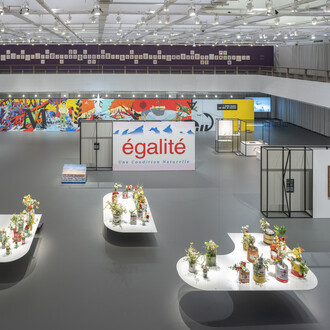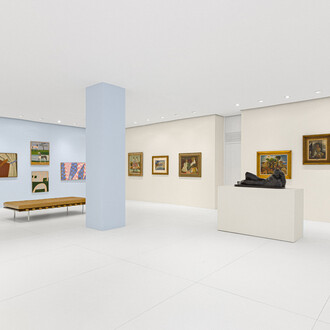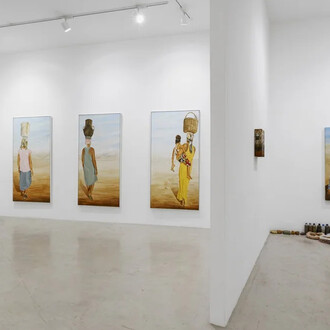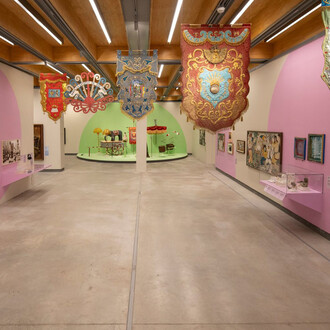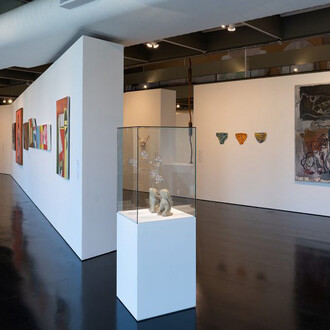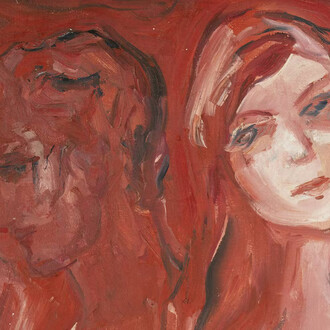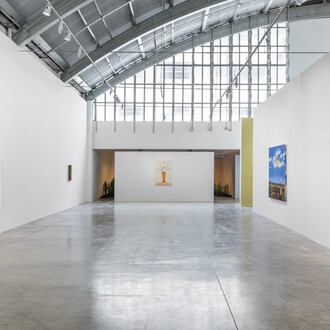The Bergamin Gomide Gallery, on the occasion of the Bruno Munari – always a new thing exhibition, presents a remarkable group of works by the Italian artist, which is considered one of the multifaceted figures of the art in the 20th century. The title, deriving from the famous book Da cosa nasce cosa, gives a sense of his work and research that he developed since the early 1920s to the end of his career, more than 70 years later, in 1998.
During his long career, Munari has produced his own idea of alternative reality; he belongs to the small group of key figures of the art of the last century. He was an important graphic designer, artist, designer and pedagogue; constantly in dialogue with various artistic and technical languages, as well as the diverse media that he continuously made use of. Munari is one of the few minds with a truly Leonardo-esque outlook that we have come to recognize in the recent history of art. With a strong sense of self-irony, he always avoided a sense of belonging to any singular group or artistic movement: “I was highly successful despite the general indifference towards me.”, he used to say about himself.
Geometry and refined spirit; fantasy and method; rigor and irony are keywords to understand his works, or, as he would have said, to get in touch with them, since, as soon as we start to explain it, a work no longer exists. Artists as Bayer, László Moholy-Nagy, Max Bill, Theo van Doesburg and Francis Picabia were artistic references for him, along with Filippo Tommasi Marinetti and one of the most important visionaries and experimenters among the artists in the early 20th century: Prampolini. In 1942 he published the book Le macchine inutili [Useless machines] – a decade after his first homonymous sculpture – following the aesthetic of the machine, a proposal that were very common at that time. Dada and Surrealism coexist in his work, highlighting the constant anti-positivist attitude that led him to synthesize the relationship between concept, form and style moving beyond the issues of any avant-gardist framework. From this moment forward, series of works such as Negativi positivi [Positive Negatives] would emerge, in which the artist condensed his research on visual purity, giving to colors their own unique and inherent vitality; or the Curve di Peano [Peano Curves], infinitesimal germinations of shapes hidden within the atoms of elements. Works like these demonstrate Munari’s knowledge of a book seen as fundamental for many 20th century artists: D’Arcy Thompson’s On Growth and Form, published in 1917, and broadly cited in Fantasia .
A key moment for Munari was in 1962, when he conceived and created, for Olivetti Munari, the Arte programmata. Arte cinetica. Opere moltiplicate.Opera Aperta [Programmed Art. Kinetic Art. Multiplied Works. Open Work] exhibition set up at the Milanese showroom in Galleria Vittorio Emanuele. Arte programmata is one of Bruno Munari’s linguistic inventions that defines works in which pre-determined movement is the constitutive element of the work itself, and as such is programmed, not random. The artwork thus became a visual subject/object designed to produce a particular Gestalt experience. Therefore, the illegibility of a single dominant static image and the mutual interaction of the elements in the field become fundamental aspects of his work. The theme of diversity-mutation also returns to the Presenza degli antenati [Presence of the ancestors], in Guardiamoci negli occhi [Look into my eyes], which take up again the Libro illeggibile [Illegible book]: it’s the continuous mutability within the persistence of a form such as the face, or human descent; the continuity-discontinuity side by side in the phenomenology of the real.
At this point the illegible writings of ancient populations appear, as well as the distortions/interpretations of everyday objects, such as forks that become gestures and an alphabet. During these years, Munari has moved away from the movement of programmed or kinetic art and has worked with creative methods that were related to the precepts of Zen philosophy – as the dialectic between the principle of fullness and emptiness.
Between February and May 1967, he was invited to teach Advanced Explorations and Visual Communication in Harvard University and published “a highly technical book on the new means of visual communication,”, titled “Design e comunicazione” [Design and communication]. In Munari lies an ironic radicalism aware of a trans-disciplinary epistemology that made him one of the most autonomous and extraordinary figures of the last century. We could continue speaking of his work as a writer, an advertiser, an experimental filmmaker, a participant in a practice of art as political action and tool of social intervention, as in Campo Urbano [Urban Field] in 1969. To enter Munari’s world, it is important to keep in mind his continuous participation in the choice, organization and discussion of the selected parts. Creativity is a synthesis of imaginative freedom and inventive accuracy, the latter being the result of meticulous analysis and, therefore, a consequence of what is fair.
Text by Alberto Salvadori
![Bruno Munari (1907-1998)
Forchetta parlante, 1958-1991, Ed. 18/20
Garfo torcido sobre madeira
[Bent fork on wood]
15 x 7 x 3 cm [5 7/8 x 2 3/4 x 1 1/8 in.]](http://media.meer.com/attachments/321f843c88b622e1b20039fb1663d40264dba772/store/fill/1090/613/fddfcc2bc266d3812450a83789a0c87812d6adba2c5fe72080b1c3b22654/Bruno-Munari-1907-1998-Forchetta-parlante-1958-1991-Ed-18-slash-20-Garfo-torcido-sobre-madeira.jpg)

![Bruno Munari (1907-1998)
Studio di design, 1947
Técnica mista sobre cartão
[Mixed media on cardboard]
34 x 24 cm [13 3/8 x 9 3/8 in.]](http://media.meer.com/attachments/899e266897c574139f5ae68a0a96f2e9320f81e6/store/fill/410/615/e94d965ec000e1cb22299fbc13fc6eebbb90bd8dd6c6dac64a4dbf4efe34/Bruno-Munari-1907-1998-Studio-di-design-1947-Tecnica-mista-sobre-cartao-Mixed-media-on-cardboard.jpg)
![Bruno Munari (1907-1998)
Negativo – Positivo, 1986
Óleo sobre tela [Oil on canvas]
88 x 60 cm [34 5/8 x 23 1/2 in.]](http://media.meer.com/attachments/d5a23b3078258fd1b6df0d208f53c16a633d6b13/store/fill/410/615/9bbd1e22843c1a539e603c5fe229e4422ffd782630525ba5c9865fbe9989/Bruno-Munari-1907-1998-Negativo-Positivo-1986-leo-sobre-tela-Oil-on-canvas-88-x-60-cm-34-5-slash.jpg)
![Bruno Munari (1907-1998)
Studio di design, 1947
Colagem e técnica mista sobre cartão
[Collage and mixed media on cardboard]
34 x 24 cm [13 3/8 x 9 3/8 in.]](http://media.meer.com/attachments/2bcb40752759ad3b9924f64b9372d6d605e663a6/store/fill/410/615/08347ebf89c1479b9b642b348f62023658fd834c479aacd2e41f0d38e404/Bruno-Munari-1907-1998-Studio-di-design-1947-Colagem-e-tecnica-mista-sobre-cartao-Collage-and.jpg)


![Bruce Conner (1933-2008)
BREAKAWAY, 1966
Filme 16mm em preto e branco
[Black and white 16mm film]
5 min
BC-0019
Courtesy: The Conner Family Trust, Kohn Gallery and Bergamin & Gomide](http://media.meer.com/attachments/7d07aa708db7f25e05333b5b262166f49883bfa7/store/fill/330/330/839c49e290870e0a9fe994df5e0c140d163ec7ca78a6019e5e8b269855f1/Bruce-Conner-1933-2008-BREAKAWAY-1966-Filme-16mm-em-preto-e-branco-Black-and-white-16mm-film-5.jpg)

